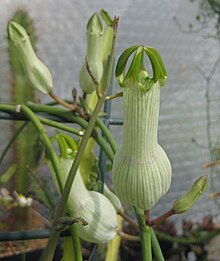Ceropegia ampliata
| Ceropegia ampliata | |
|---|---|

| |
| Ceropegia ampliata in cultivation | |
| Scientific classification | |
| Kingdom: | Plantae |
| Clade: | Tracheophytes |
| Clade: | Angiosperms |
| Clade: | Eudicots |
| Clade: | Asterids |
| Order: | Gentianales |
| Family: | Apocynaceae |
| Genus: | Ceropegia |
| Species: | C. ampliata
|
| Binomial name | |
| Ceropegia ampliata | |
Ceropegia ampliata is a flowering plant in the dogbane family Apocynaceae, native to eastern and southern Africa, including Kenya, Tanzania, Mozambique, South Africa, Eswatini, Botswana, and Madagascar.[1][2] Common names include bushman's pipe, condom plant, and horny wonder.[3][4]
Description
[edit]Ceropegia ampliata is a trailing plant with a succulent stem and reduced leaves. The leaves may drop early, as the stem is the main photosynthetic organ, and it may form tuberous root structures.[3] Like many Ceropegia, pollination occurs by trapping insects inside of flowers with stiff hairs until a pollenium is attached to the insect's leg or tongue through anther slits on the corona.[5][6][7] Unlike other related species however, it is described as extremely generalist and is pollinated by flies from between four and seven fly families.[8][9]
The flowers of this species are white and light green, occasionally with a light purple ring along the tube. The corolla tube can be curved or straight, with an inflation at the base, and can grow up to 50-70 mm long. They often flower between December and March in their natural habitat. After the fruit follicles dry out and split, the tufted seeds are dispersed by wind.[3]
References
[edit]- ^ Retief, E (1997). Plants of the Northern Provinces of South Africa: keys and diagnostic characters. Pretoria, South Africa: National Botanical Institute. ISBN 9781874907305.
- ^ Meve, Ulrich; Liede, Sigrid (July 2002). "Floristic exchange between mainland Africa and Madagascar: case studies in Apocynaceae- Asclepiadoideae". Journal of Biogeography. 29 (7): 865–873. doi:10.1046/j.1365-2699.2002.00729.x. ISSN 0305-0270. S2CID 84765967.
- ^ Jump up to: a b c Bester, Stoffel Petrus. "Ceropegia ampliata". Plant Z Africa. South African National Biodiversity Institute. Retrieved 30 April 2023.
- ^ "Ceropegia ampliata". Top Tropicals. Retrieved 30 April 2023.
- ^ Heiduk, A.; Brake, I.; Tolasch, T.; Frank, J.; Jürgens, A.; Meve, U.; Dötterl, S. (2010-10-01). "Scent chemistry and pollinator attraction in the deceptive trap flowers of Ceropegia dolichophylla". South African Journal of Botany. Chemical diversity and biological functions of plant volatiles. 76 (4): 762–769. doi:10.1016/j.sajb.2010.07.022. ISSN 0254-6299.
- ^ Reynolds, Sage. "Ceropegia ampliata". www.sagereynolds.com. Archived from the original on 30 November 2022. Retrieved 2023-07-26.
- ^ Bayer, M. B. (March 1978). "Pollination in Asclepiads". Veld & Flora. pp. 21–23. Archived from the original on 26 July 2023. Retrieved 25 July 2023.
- ^ Coombs, Gareth; Dold, Anthony P.; Peter, Craig I. (2011-09-01). "Generalized fly-pollination in Ceropegia ampliata (Apocynaceae–Asclepiadoideae): the role of trapping hairs in pollen export and receipt". Plant Systematics and Evolution. 296 (1): 137–148. doi:10.1007/s00606-011-0483-6. ISSN 1615-6110. S2CID 36698383.
- ^ Ollerton, Jeff; Dötterl, Stefan; Ghorpadé, Kumar; Heiduk, Annemarie; Liede-Schumann, Sigrid; Masinde, Siro; Meve, Ulrich; Peter, Craig I.; Prieto-Benítez, Samuel; Punekar, Sachin; Thulin, Mats; Whittington, Andrew (2017-09-01). "Diversity of Diptera families that pollinate Ceropegia (Apocynaceae) trap flowers: An update in light of new data and phylogenetic analyses". Flora. 234: 233–244. doi:10.1016/j.flora.2017.07.013. ISSN 0367-2530. S2CID 62789697.
